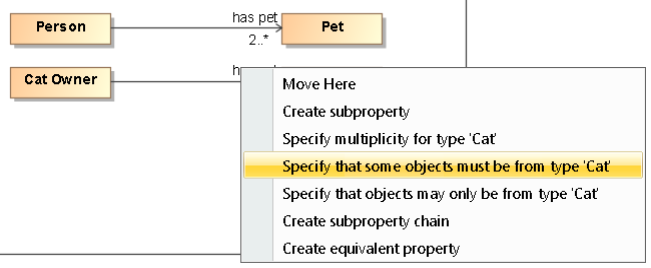Page History
There are two kinds of cardinality restrictions: qualified and and unqualified. This This page will explain explains both kinds, but we must consider the following set-up model.
...
- Create four classes and two unidirectional object properties such that it looks like the following figureas shown below.
- Drag and drop the top top has pet property property onto the bottom bottom has pet property property until you the see the Create subproperty text text.
- Once you drop the property, you should see the following menu will appear. Select the highlighted option highlighted.
- The result should be the following figurelook as shown below. Notice the restriction {subset has pet}.
- Now, we export to OWL.
| Warning | ||
|---|---|---|
| ||
In order to follow the rest of the explanation, please set your OWL export syntax to OWL Functional as shown in the following figurebelow. |
Excerpt of the OWL ontology
The following code block shows a an excerpt of the OWL ontology that marks the distinction between qualified and unqualified cardinality restrictions.
...
From the OWL ontology excerpt above, line 6 shows an unqualified cardinality restriction. This It is an unqualified cardinality restriction because the property's type emanating from from Person, Pet with with cardinality of of 2..* does not specify the the Pet, such as such as Cat, that the that the Person could could have.
Qualified Cardinality Restriction
From the OWL ontology excerpt above, line 4 shows a qualified cardinality restriction. This It is a qualified cardinality restriction because the property's type emanating from from Cat Owner, Cat with cardinality with cardinality 2..3 specifies specifies the pet, Cat, and and the restriction actually says
...

